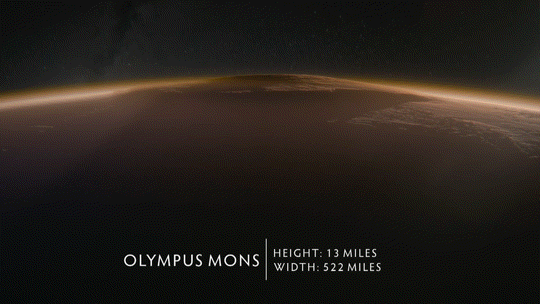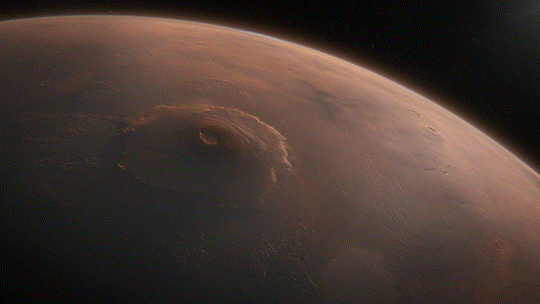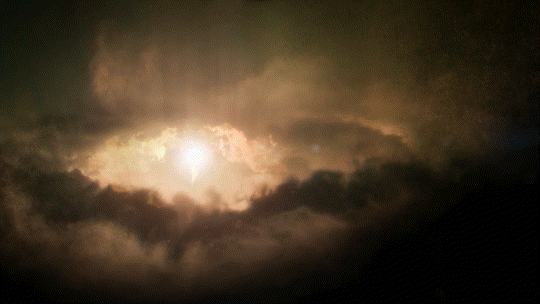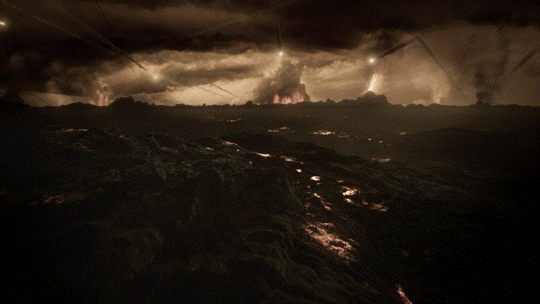#Solar system and beyond
Explore tagged Tumblr posts
Video
NASA’s Juno Mission Gets Under Jupiter’s and Io’s Surface by NASA's Marshall Space Flight Center Via Flickr: New data from the agency’s Jovian orbiter sheds light on the fierce winds and cyclones of the gas giant’s northern reaches and volcanic action on its fiery moon. NASA’s Juno mission has gathered new findings after peering below Jupiter’s cloud-covered atmosphere and the surface of its fiery moon, Io. Not only has the data helped develop a new model to better understand the fast-moving jet stream that encircles Jupiter’s cyclone-festooned north pole, it’s also revealed for the first time the subsurface temperature profile of Io, providing insights into the moon’s inner structure and volcanic activity. JunoCam, the visible light imager aboard NASA’s Juno, captured this enhanced-color view of Jupiter’s northern high latitudes from an altitude of about 36,000 miles (58,000 kilometers) above the giant planet’s cloud tops during the spacecraft’s 69th flyby on Jan. 28, 2025. Credit: Image data: NASA/JPL-Caltech/SwRI/MSSS Image processing: Jackie Branc (CC BY) #NASA #MarshallSpaceFlightCenter #MSFC #Marshall #jpl #nasamarshall #juno #nasajuno #moon #Io Read more More about Juno NASA Media Usage Guidelines
#NASA#Marshall Space Flight Center#MSFC#Jet Propulsion Laboratory#JPL#Solar system and beyond#Juno#Jupiter#Space#planets#Io#moon#flickr
9 notes
·
View notes
Text

Giant volcanoes on Mars dwarf anything seen on Earth, one so wide it would cover the length of Nevada, and one so tall it reaches over twice the height of Mount Everest. It’s the largest volcano in the solar system.

Lava once flowed from these giants, spilling across the land in all directions, so much molten rock that the combined mass tipped the planet over on its axis, by about 20 degrees.


Four-and-a-half-billion years ago, with the rest of the solar system, Mars formed from the collapse of a cloud of gas and dust being smashed together, under the force of its own gravity.

Much of the energy that went into these collisions turned into heat, trapped inside, driving volcanism on a staggering scale.

It really is just incredible that so much of the heat that powered these volcanoes can be traced back four-and-a-half-billion years ago, to the formation of the planet.
Solar System: Volcano Worlds on NOVA
#before this i never really processed#where the heat inside the planet came from#beyond just radiation#wild that it was captured idk#solar system#astronomy#space#mars#pbs nova
143 notes
·
View notes
Text

Enceladus
49 notes
·
View notes
Text

Hwow... Tagalog is such a fascinating language
#was curious about the name of our solar system beyond “The Solar System” (wikipedia thinks there isn't)#remembered that the sun is sometimes called sol and I looked at its page and saw that it's also called helios#so I then naturally remembered that the moon is called luna sometimes so I wondered if it had an alternate name (maybe artemis or something)#found that it does but it's not artemis it's selene (makes sense) and cynthia#and I was like “oh I wonder why cynthia” and clicked it assuming it'd take me to the page of some sort of goddess or figure of myth/legend#and it took me to the etymology page for the name cynthia. and the wikipedia etymology modules are apparently not working#fascinating journey I went on there
3 notes
·
View notes
Text
Been trying to read Jules Verne's Journey to the Moon because it was one of my grandfather's favorite books, but it's also just fuckin chalk full of technical details about the orbit of the moon that I have already memorized for class ages ago and I am wondering if it is maybe the compilation of technical details that he loved more than the story.
#The story is good tbf it's just also told to some degree around the technical stuff#Which is definitely given a pretty central role in the story#IDK maybe it's less like that after chapter 6#I am just having trouble maintaining steam through the third chapter of stuff I memorized for one of the two astronomy classes I took#One in high school and one at a college level#Anyhow I will get to and through this book it's just tough mentally#Cause of how much some of it feels like school#lol tbf some of these details I memorized by playing a bunch of Kerbal Space Program#I've been playing a real solar system mod pack and that not class is where I learned the delta v budget you need to get to the moon#Which they spend all at once but also which matches my understanding of the number pretty well#Barring an extra km/s that Verne probably is using to account for the extra drag of the cannon approach vs the rocketry approach#And also tbf I do not know the technical details about cannon manufacture at all beyond some of the basic materials physics stuff#They compel me less than the space details I do know tho#I also do very much love that the premise of the whole thing is 'Americans sure do fuckin love their guns'#Like the character stuff is genuinely fun and well done#It's just against every other chapter being a technical manual on some aspect of the thing#And a technical manual whose details I either know or know are outdated by better newer understandings#Like the creation of the planet section is kinda right but mostly wrong by modern understandings#But also does reflect the best understanding of the time but also I know the history of these ideas anyhow
4 notes
·
View notes
Text

You would not be wrong
Actually that makes for a really funny poll idea
17K notes
·
View notes
Text
Explore the latest scientific discoveries and theories about the potential existence of extraterrestrial life beyond our solar system. Are we truly alone in the universe?
#life beyond solar system#exoplanets#extraterrestrial life#alien discovery#habitable planets#space exploration#NASA#astrobiology#TheJuniorAge#KidsNewspaper#Newspaper For Children#KidsNewspaperIndia
0 notes
Text
One thing about me is that despite enjoying sci-fi, I am not one bit interested in space.
Space is scary and freaky and I trust it about as far as I can throw it, which is not at all.
If technology advances to a point where space travel is accessible to all, I’m staying right here on my cosy little blue marble, thank you very much.
#the marchioness rambles#I like our solar system and that’s it#Go beyond Pluto and I start getting anxious#Terrified of the idea of being sucked out into the vacuum of space#I saw that one episode of Magic School Bus where Arnold’s face froze and that was as enough for me#I should be more interested in it#But the cosmos is terrifying to me I do not want to comprehend it get that lovecraftian nonsense away from me#I love science though :—)#The ocean also kind of freaks me out#albeit far less.
1 note
·
View note
Video
O Christmas Tree! by NASA's Marshall Space Flight Center Via Flickr: A new version of the “Christmas tree cluster” is now available. Like NGC 602, NGC 2264 is a cluster of young stars between one and five million years old. (For comparison, the Sun is a middle-aged star about 5 billion years old — about 1,000 times older.) In this image of NGC 2264, which is much closer than NGC 602 at a distance of about 2,500 light-years from Earth, data from NASA's Chandra X-ray Observatory (red, purple, blue, and white) has been combined with optical data (green and violet) captured from by astrophotographer Michael Clow from his telescope in Arizona in November 2024. Credit: X-ray: NASA/CXC/SAO; Optical: Clow, M.; Image Processing: NASA/CXC/SAO/L. Frattare and K. Arcand #NASAMarshall #NASA #astrophysics #NASAChandra #NASA #JWST #NASAWebb #star #starcluster Read more Read more about the Chandra X-ray Observatory NASA Media Usage Guidelines
#NASA#NASA's Marshall Space Flight Center#NASA Marshall#Marshall#MSFC#Solar System & Beyond#astronomy#astrophysics#Chandra X-Ray Observatory#star#star cluster#flickr
101 notes
·
View notes
Text

What does it take to see this?
Decades of dreamers, inventors, scientists and artists working together to create a labor of love: a telescope capable of peering deep into the universe and back through time.
The James Webb Space Telescope has allowed us to see the earliest galaxies, the auroras and rings on our gas giants, and even detect clouds on planets far beyond our solar system, all because a group of dreamers looked at the universe with curiosity.
Witness the incredible story of Webb’s journey – from an impossible idea to a scientific marvel – all through the eyes of the people who made it possible in our new documentary. Cosmic Dawn is streaming now on NASA+.
#NASA#James Webb Space Telescope#astrophotography#space photography#space#galaxies#documentary#film#astronomy#engineering#technology#tech
3K notes
·
View notes
Text
Super Earth
Explore TOI-715 b, a super-Earth in a distant solar system, and join the quest for alien worlds beyond the stars. 🌌🪐 #SpaceExploration
#Explore TOI-715 b#a super-Earth in a distant solar system#and join the quest for alien worlds beyond the stars. 🌌🪐#SpaceExploration
0 notes
Text
"The man who has called climate change a “hoax” also can be expected to wreak havoc on federal agencies central to understanding, and combating, climate change. But plenty of climate action would be very difficult for a second Trump administration to unravel, and the 47th president won’t be able to stop the inevitable economy-wide shift from fossil fuels to renewables.
“This is bad for the climate, full stop,” said Gernot Wagner, a climate economist at the Columbia Business School. “That said, this will be yet another wall that never gets built. Fundamental market forces are at play.”
A core irony of climate change is that markets incentivized the wide-scale burning of fossil fuels beginning in the Industrial Revolution, creating the mess humanity is mired in, and now those markets are driving a renewables revolution that will help fix it. Coal, oil, and gas are commodities whose prices fluctuate. As natural resources that humans pull from the ground, there’s really no improving on them — engineers can’t engineer new versions of coal.
By contrast, solar panels, wind turbines, and appliances like induction stoves only get better — more efficient and cheaper — with time. Energy experts believe solar power, the price of which fell 90 percent between 2010 and 2020, will continue to proliferate across the landscape. (Last year, the United States added three times as much solar capacity as natural gas.) Heat pumps now outsell gas furnaces in the U.S., due in part to government incentives. Last year, Maine announced it had reached its goal of installing 100,000 heat pumps two years ahead of schedule, in part thanks to state rebates. So if the Trump administration cut off the funding for heat pumps that the IRA provides, states could pick up the slack.

Local utilities are also finding novel ways to use heat pumps. Over in Massachusetts, for example, the utility Eversource Energy is experimenting with “networked geothermal,” in which the homes within a given neighborhood tap into water pumped from underground. Heat pumps use that water to heat or cool a space, which is vastly more efficient than burning natural gas. Eversource and two dozen other utilities, representing about half of the country’s natural gas customers, have formed a coalition to deploy more networked geothermal systems.
Beyond being more efficient, green tech is simply cheaper to adopt. Consider Texas, which long ago divorced its electrical grid from the national grid so it could skirt federal regulation. The Lone Star State is the nation’s biggest oil and gas producer, but it gets 40 percent of its total energy from carbon-free sources. “Texas has the most solar and wind of any state, not because Republicans in Texas love renewables, but because it’s the cheapest form of electricity there,” said Zeke Hausfather, a research scientist at Berkeley Earth, a climate research nonprofit. The next top three states for producing wind power — Iowa, Oklahoma, and Kansas — are red, too.
State regulators are also pressuring utilities to slash emissions, further driving the adoption of wind and solar power. As part of California’s goal of decarbonizing its power by 2045, the state increased battery storage by 757 percent between 2019 and 2023. Even electric cars and electric school buses can provide backup power for the grid. That allows utilities to load up on bountiful solar energy during the day, then drain those batteries at night — essential for weaning off fossil fuel power plants. Trump could slap tariffs on imported solar panels and thereby increase their price, but that would likely boost domestic manufacturing of those panels, helping the fledgling photovoltaic manufacturing industry in red states like Georgia and Texas.
The irony of Biden’s signature climate bill is states that overwhelmingly support Trump are some of the largest recipients of its funding. That means tampering with the IRA could land a Trump administration in political peril even with Republican control of the Senate, if not Congress. In addition to providing incentives to households (last year alone, 3.4 million American families claimed more than $8 billion in tax credits for home energy improvements), the legislation has so far resulted in $150 billion of new investment in the green economy since it was passed in 2022, boosting the manufacturing of technologies like batteries and solar panels. According to Atlas Public Policy, a research group, that could eventually create 160,000 jobs. “Something like 66 percent of all of the spending in the IRA has gone to red states,” Hausfather said. “There certainly is a contingency in the Republican party now that’s going to support keeping some of those subsidies around.”
Before Biden’s climate legislation passed, much more progress was happening at a state and local level. New York, for instance, set a goal to reduce its greenhouse gas emissions from 1990 levels by 40 percent by 2030, and 85 percent by 2050. Colorado, too, is aiming to slash emissions by at least 90 percent by 2050. The automaker Stellantis has signed an agreement with the state of California promising to meet the state’s zero-emissions vehicle mandate even if a judicial or federal action overturns it. It then sells those same cars in other states.
“State governments are going to be the clearest counterbalance to the direction that Donald Trump will take the country on environmental policy,” said Thad Kousser, co-director of the Yankelovich Center for Social Science Research at the University of California, San Diego. “California and the states that ally with it are going to try to adhere to tighter standards if the Trump administration lowers national standards.”
[Note: One of the obscure but great things about how emissions regulations/markets work in the US is that automakers generally all follow California's emissions standards, and those standards are substantially higher than federal standards. Source]
Last week, 62 percent of Washington state voters soundly rejected a ballot initiative seeking to repeal a landmark law that raised funds to fight climate change. “Donald Trump’s going to learn something that our opponents in our initiative battle learned: Once people have a benefit, you can’t take it away,” Washington Governor Jay Inslee said in a press call Friday. “He is going to lose in his efforts to repeal the Inflation Reduction Act, because governors, mayors of both parties, are going to say, ‘This belongs to me, and you’re not going to get your grubby hands on it.’”
Even without federal funding, states regularly embark on their own large-scale projects to adapt to climate change. California voters, for instance, just overwhelmingly approved a $10 billion bond to fund water, climate, and wildfire prevention projects. “That will be an example,” said Saharnaz Mirzazad, executive director of the U.S. branch of ICLEI-Local Governments for Sustainability. “You can use that on a state level or local level to have [more of] these types of bonds. You can help build some infrastructure that is more resilient.”
Urban areas, too, have been major drivers of climate action: In 2021, 130 U.S. cities signed a U.N.-backed pledge to accelerate their decarbonization. “Having an unsupportive federal government, to say the least, will be not helpful,” said David Miller, managing director at the Centre for Urban Climate Policy and Economy at C40, a global network of mayors fighting climate change. “It doesn’t mean at all that climate action will stop. It won’t, and we’ve already seen that twice in recent U.S. history, when Republican administrations pulled out of international agreements. Cities step to the fore.”
And not in isolation, because mayors talk: Cities share information about how to write legislation, such as laws that reduce carbon emissions in buildings and ensure that new developments are connected to public transportation. They transform their food systems to grow more crops locally, providing jobs and reducing emissions associated with shipping produce from afar. “If anything,” Miller said, “having to push against an administration, like that we imagine is coming, will redouble the efforts to push at the local level.”
Federal funding — like how the U.S. Forest Service has been handing out $1.5 billion for planting trees in urban areas, made possible by the IRA — might dry up for many local projects, but city governments, community groups, and philanthropies will still be there. “You picture a web, and we’re taking scissors or a machete or something, and chopping one part of that web out,” said Elizabeth Sawin, the director of the Multisolving Institute, a Washington, D.C.-based nonprofit that promotes climate solutions. “There’s this resilience of having all these layers of partners.”
All told, climate progress has been unfolding on so many fronts for so many years — often without enough support from the federal government — that it will persist regardless of who occupies the White House. “This too shall pass, and hopefully we will be in a more favorable policy environment in four years,” Hausfather said. “In the meantime, we’ll have to keep trying to make clean energy cheap and hope that it wins on its merits.”"
-via Grist, November 11, 2024. A timely reminder.
#climate change#climate action#climate anxiety#climate hope#united states#us politics#donald trump#fuck trump#inflation reduction act#clean energy#solar power#wind power#renewables#good news#hope
2K notes
·
View notes
Text
Exploring Our Solar System: A Comprehensive Guide.
Introduction The cosmos, with its vast and mysterious expanse, has captivated human curiosity throughout the ages, urging us to look beyond the familiar boundaries of our terrestrial home. Our solar system, a captivating assembly of celestial bodies, has been a subject of continuous scientific exploration for centuries. In this detailed article, we embark on an enlightening journey, delving into…

View On WordPress
0 notes
Text

Idk, my mind wanders around in space sometimes
1 note
·
View note
Text
Hi this is pirate third acc! This blog manly focuses on objects beyond the solar system!
1 note
·
View note
Video
Eccentric ‘Star’ Defies Easy Explanation, NASA’s Chandra Finds by NASA's Marshall Space Flight Center Via Flickr: Scientists have discovered a star behaving like no other seen before, giving fresh clues about the origin of a new class of mysterious objects. This composite image features a mysterious object, possibly an unusual neutron star or white dwarf, residing near the edge of a supernova remnant. The object, known as ASKAP J1832, has been intriguing astronomers from the Chandra X-ray Observatory and Square Kilometre Array Pathfinder radio telescope with its antics and bizarre behavior. Astronomers have discovered that ASKAP J1832 cycles in radio wave intensity every 44 minutes. This is thousands of times longer than pulsars, which are rapidly spinning neutron stars that have repeated variations multiple times a second. Using Chandra, the team discovered that the object is also regularly varying in X-rays every 44 minutes. This is the first time such an X-ray signal has been found in a long period radio transient like ASKAP J1832. Credit: X-ray: NASA/CXC/ICRAR, Curtin Univ./Z. Wang et al.; Infrared: NASA/JPL/CalTech/IPAC; Radio: SARAO/MeerKAT; Image processing: NASA/CXC/SAO/N. Wolk #NASAMarshall #NASA #astrophysics #NASAChandra #Space #Chandra #Telescope #Universe #LongPeriodRadioTransients Listen to all three sonifications Read more about the Chandra X-ray Observatory NASA Media Usage Guidelines
#NASA#NASA's Marshall Space Flight Center#NASA Marshall#Marshall#MSFC#Solar System & Beyond#astronomy#astrophysics#Chandra X-Ray Observatory#long period radio transients#flickr
8 notes
·
View notes

